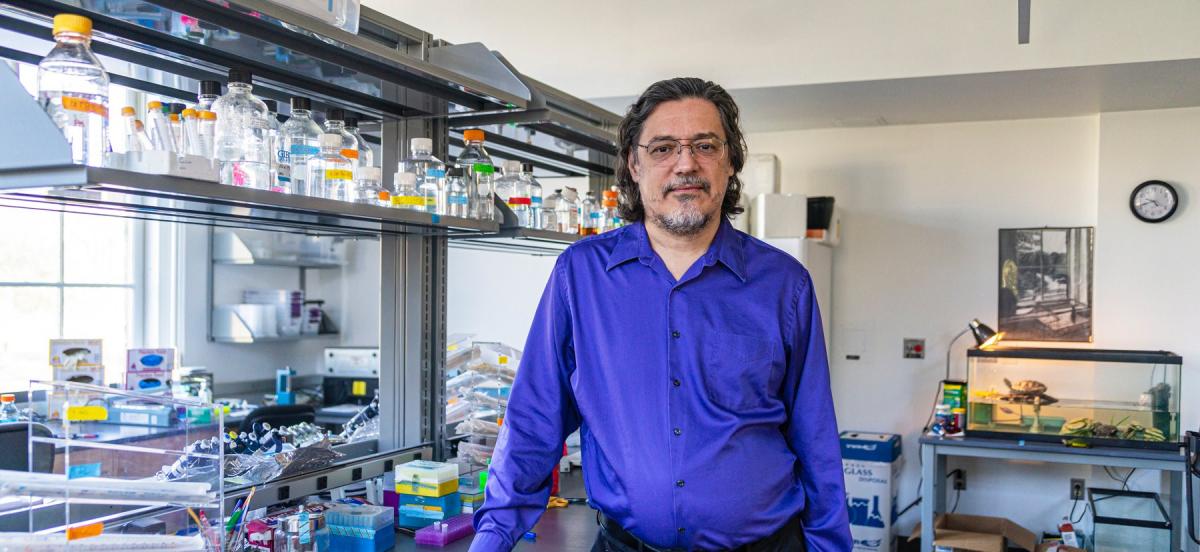Office Hour: Rob Fairman

Photo: Patrick Montero
The professor of biology gives us a tour of his office.
Since joining the Haverford faculty in 1997, Professor of Biology Rob Fairman has taught a wide array of courses, including “Protein Folding and Design,” “Molecules, Cells, and Organisms,” and “Genetic Roil and Royal Families,” which looks at the biology of inherited conditions through the lens of royal intermarriage. A widely published researcher, Fairman studies protein polymerizing systems and is working on better understanding the protein aggregation that underlies diseases such as Huntington’s, ALS, and Alzheimer’s. Fairman, who earned his Ph.D. in biochemistry at Stanford University, has served as associate provost of the College, and played a leadership role in the renovation of Sharpless Hall that transformed the building into a bright, modern home for two of Haverford’s most popular majors, biology and psychology—and where he now occupies a sunny office and adjoining lab. Known as a warm and encouraging mentor to budding scientists, Fairman worked with Assistant Professor of Chemistry Lou Charkoudian ’03 to launch the “Biochem Superlab” course, whose structure encourages students to generate their own hypotheses and create their own experiments to test those hypotheses. The 2015 inaugural class, along with its professors, went on to publish a peer-reviewed paper in PLoS Biology in 2017. Titled “Uncovering protein-protein interactions through a team-based undergraduate biochemistry course,” the paper detailed the results of in-class research as well as how the course was designed to facilitate that research.

➊ Lending library: I’m teaching a brandnew course called “The Science and Practice of Mindfulness,” and this is a whole library I’ve built of books on the subject that students can borrow. I’ve been studying neurodegenerative diseases like Huntington’s and Alzheimer’s for a long time, and my research has moved more and more into neurobiology. Now I’m interested in how we’re learning to deal with mental health. Mindfulness is one approach. So in the class, we’re looking at the techniques being used to study the science, like MRI scans that look at how the brain gets rewired when you’re practicing mindfulness. You can also look at cortisol levels, and monitor blood pressure and pulse. I’m inviting someone to come train the class in shinrin yoku—or forest bathing, mindfulness practice done in the woods. Then they’re going to be using different protocols that they will select to measure the effects of forest bathing on physiology.

➋ Family photos: My wife, Susan, is the secretary at Lynnewood Elementary School in Havertown. She’s been working in the school district for 23 years, which is as long as I’ve been at Haverford. And those are my two sons. My younger son, Drew, on the left, is 29 now and works at Haverford as a campus safety officer. That’s Brian on the right, who’s 33. He was teaching high school, but now he works full-time for a technology summer camp. He’s in charge of their curriculum. So we all work in education.

➌ His turtle, Balthazar: We didn’t know she was a she when we named her that. She’s a red-eared slider and she’s about 15 years old, but they can live for 80 or 90 years. She’s bruminating now, which is hibernation for a turtle. In the wild, they bury themselves under the mud and don’t eat for two or three months. And that’s Balthazar almost 10 years ago in the drawing above the tank. That was done by Julia Durante ’11, who’s now doing her pediatrics residency.

➍ Beckman Analytical Ultracentrifuge: Neurodegenerative diseases share a common underlying molecular mechanism involving proteins that glom up to form these really large structures. The question we’ve been trying to answer is: How big are they, and which forms cause the disease? This instrument allows you to analyze the size of these polymers, and then you can try to correlate that with toxicity in animal model systems. My career was built on this machine. There aren’t many of them in the world. I had it when I worked at Bristol-Myers-Squibb before I came to Haverford. When they bought a new one, I negotiated with the manufacturer to store this one for me and Haverford gave me start-up money to bring it here. I have 85 scientific publications, and about 40 of them are the result of people asking me to join them to do work that takes advantage of this instrument.

➎ Figurines: They were gifts from my students. That’s Spock, from Star Trek, and Gandalf, the wizard from Lord of the Rings, which I am a huge fan of. That was what inspired me to start writing a fantasy series myself. It’s going to be a trilogy, and it’s about scientists who turn into elves after injecting themselves with genes that are supposed to make them live longer. So it starts off in the science realm, and it’s not only about what it’s like to live for 1,000 years, there’s also an environmental arc: Elves live in the forests, and all the trees are being chopped down. What’s also informing me right now is the novel The Overstory, which won the Pulitzer Prize last year and is all about trees. My story shares a premise with that. The elves become so attuned to the trees that they wind up recognizing that we need to save the world by replanting the forests.

➏ Rocky Mountain National Park poster: I spent part of a sabbatical working in a lab in Boulder, and I spent a lot of time hiking in the park. I couldn’t go up to the highest peak; I’m not athletic enough. But I did climb Flattop Mountain, which has an elevation of 12,324 feet. I made it to the top, but barely, because what Flattop is known for is high winds. It’s a constant 40 miles an hour, with gusts up to 90. So I was bent over trying to climb to the top. It was pretty scary. I thought I was going to die.